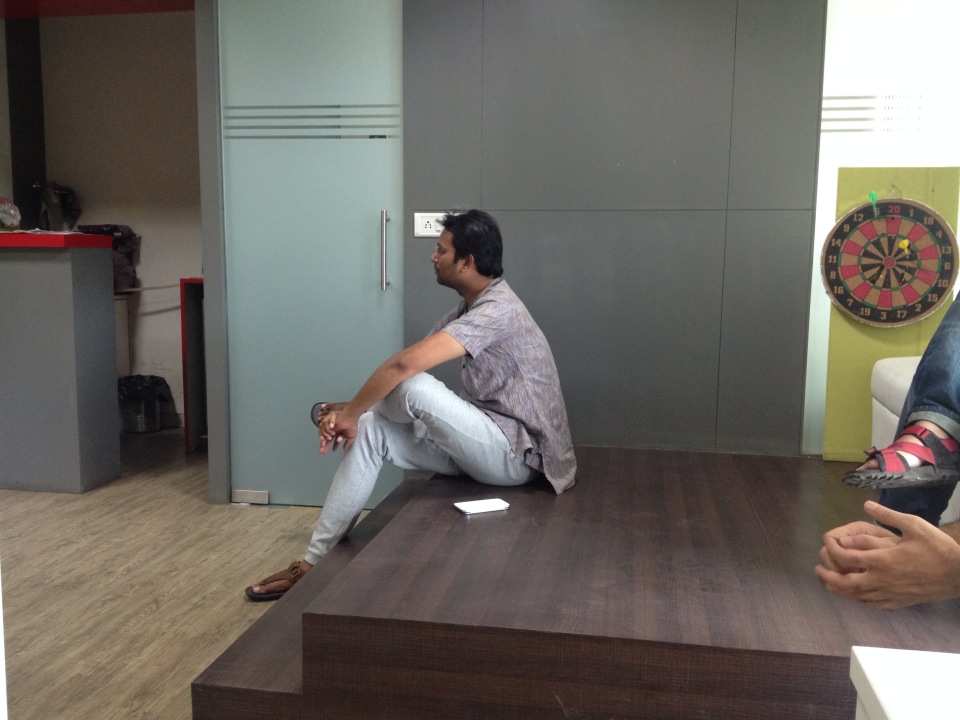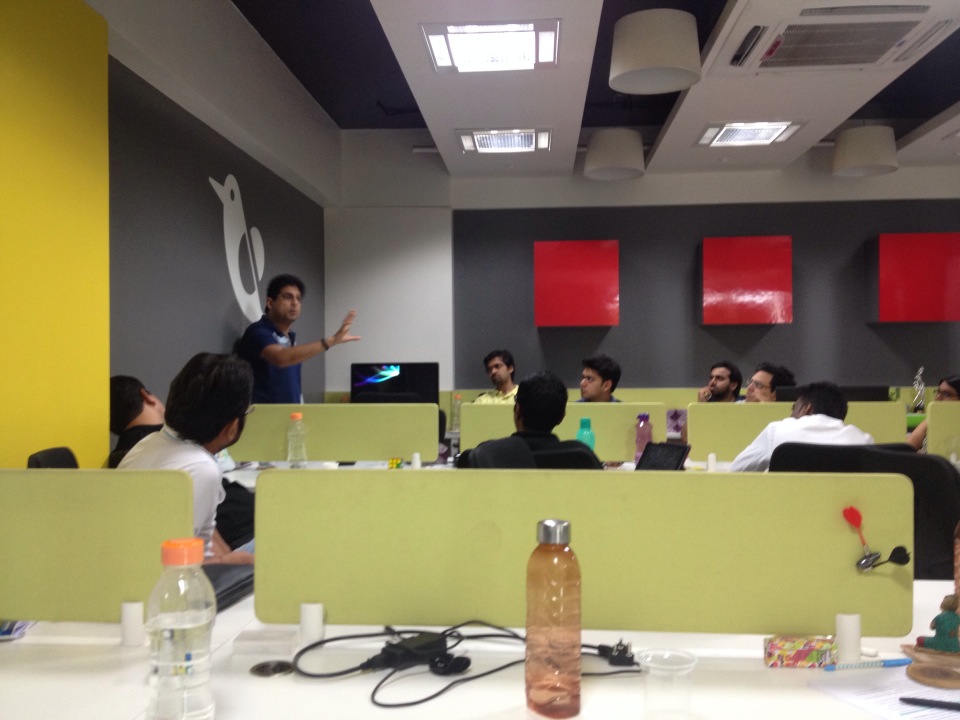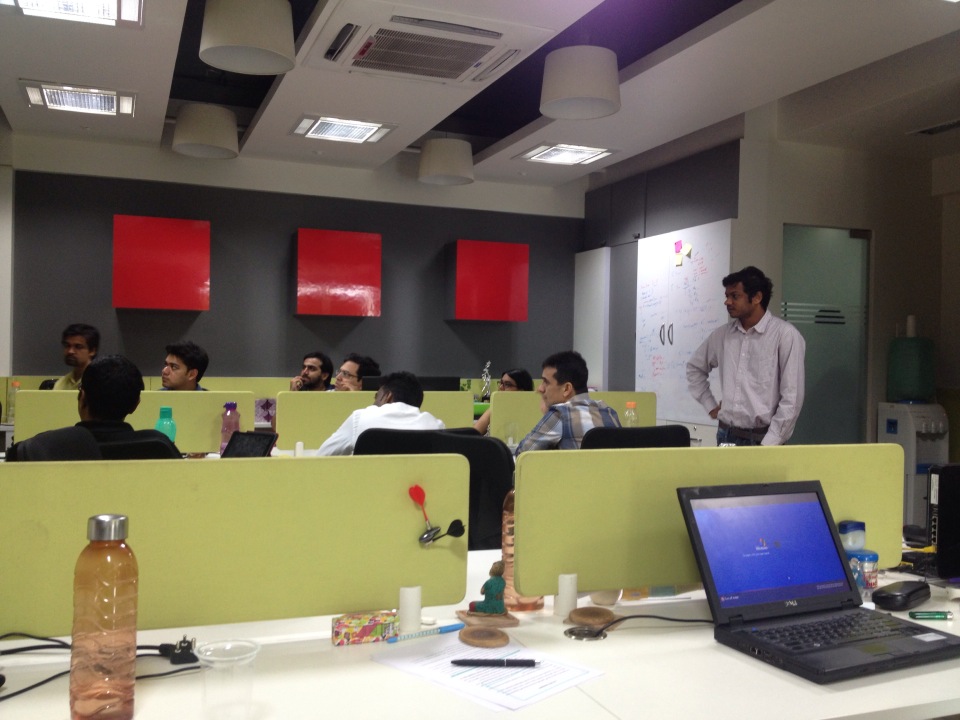Saturday, June 16 was the day, the iSPIRT Playbook Roundtable finally arrived in Mumbai. The topic for the Roundtable was Nuances of Customer Acquisition.
The Roundtable was hosted at the office of WebEngage by their CEO Avlesh Singh and saw participation from CEOs of around 14 startups from in and around Mumbai.
 The event went on for around 6 hours but given the variety of issues discussed each issue could be touched upon briefly. Since this was the initial event of this kind in Mumbai, a lot of participants were meeting each other for the first time. Some time therefore had to be spent in understanding each other’s businesses, back-stories and some of the special challenges they faced.
The event went on for around 6 hours but given the variety of issues discussed each issue could be touched upon briefly. Since this was the initial event of this kind in Mumbai, a lot of participants were meeting each other for the first time. Some time therefore had to be spent in understanding each other’s businesses, back-stories and some of the special challenges they faced.
In terms of business stage, this was a very diverse group ranging from companies signing up their initial customers to those on their way to scaling up from a well established customer base. The challenges each one faced and techniques they employed were understandably different.
Some of the hot issues that got debated were effective usage of content marketing and social media for customer acquisition, working with resellers and using out of the box ideas to increase brand awareness.
Content Marketing and Social Media
There seemed to be almost unanimous feedback that there is great potential in these techniques and there will be a lot of experimentation and learning required to figure out what would work best in an Indian scenario and for that particular product category. One size definitely does not fit all, however that should not discourage you from trying. Challenges in creating content for an international audience were also discussed. A participant pointed out that one Indian company was finding it more effective to get content written by its US based team.
Different Mantras For Different Markets
There was a discussion about different customer behaviours in different Indian cities. For one company inviting potential customers to educational seminars worked well in Bangalore but did not have the same results in Mumbai. Also they saw good demand from Kolkata. The CEO of another SaaS based startup reported excellent pick up from Tier 2 and Tier 3 cities. He mentioned that if he was to begin now, he would probably focus more on those cities than the major Indian metros.
Resellers and Customization Requests
In the B2B market, even when selling SaaS products, face-to-face meetings are still important when selling in India. Resellers can really help here by providing the requisite feet on the street and leveraging their existing client relationships. However it takes a lot of time and effort to find and educate resellers.
Requests from customers for product customization are pretty common in India. This may not always be a good thing for product companies. So companies are learning to tactfully deal with such requests without jeopardizing the deal itself. This is especially important when dealing with requests from customers contacted through resellers. One of the successful tacts in dealing with customisation requests was to quote a high price which either results in good revenue or ends up in dropping the request. Either way, customisation should always be merged into the product roadmap to avoid maintenance nightmares.
 Sales Bible
Sales Bible
One of the cardinal principles in sales is to create a sales bible. Ensure that every person talks and positions the product the same way and you follow a well thought out strategy in terms of furthering the customer decision making process to your advantage. In the growth phase if this is not done, you end up having inconsistencies in your sales process which significantly reduces the chances of successful acquisition. Some high level aspects of creating your sales bible:
- Identify what kind of collateral you need
- Qualifying the customer
- Sharing price at the right stage
- Determining timeline and budget
- Figure out whether they are buying based on need or want
- Identify early on whether they are long tail prospects and how much human touch should be built into your sales cycle. Spend your time on long tail vs short tail judiciously based on the ticket size.
- Have aggressive goals and set weekly sales targets for your team
- Adhere to your sales bible and redraft it from time to time based on learnings so your process becomes better over time.
Ticket Size
Ticket size is extremely important part of customer acquisition. Your product may sell well to a Fortune 1000 company and you may make 1 sale a year. You can also position the same “product” but in a new avatar for a smaller ticket size and sell 100s every year. So traction in customer acquisition can have a major boost or roadblock depending upon how you decide your ideal target customer profile. One such customer decided to keep their ticket price to US$ 3k so as to avoid getting into budgetary approvals by the buyer organisation and got significant traction in spontaneous purchase decisions. Another participant had the reverse problem as they sell analytics tools and did not want to target SMEs who have relatively smaller spends on social media.
Other ideas
It is important to try different marketing ideas as it is difficult to judge what will click. One excellent example of an out of the box idea for brand awareness was www.chotuchaiwala.com. The company behind this saw great results from the campaign.
One of the most important lessons early on is identifying the right customer. In case of one company they started selling to graphic designers but after finding that they were not tech savvy, they shifted focus to ad agencies and found their product market fit. It also makes sense to piggy back on sales channels which are selling a complimentary product and who may be able to sell your product easily to the same target group.
Using APIs to extend your ecosystem is another effective strategy. Done well, you can then latch on to the traction in other products that you can integrate with, and therefore expand your leads inorganically.
 Free vs Paid
Free vs Paid
It is generally believed that SaaS companies offering a free plan for their products do not see many free to paid conversions. However some companies reported that the free plan allowed them to increase their brand awareness. For example if the free plan user’s web site featured the product brand, independent visitors to the web site get exposed to the brand and generate leads for selling the paid version. In effect, the free plan rarely works to convert to paid plans but serves well when used as an advertising medium. Some others used an incentive during the free trial period to sign up early and bypass the long evaluation cycle.
To sum it up, this was a very good and important beginning. And everyone is looking forward to more in-depth sessions in the coming months!
Guest Post by Shiraz Ahmed, Founder & CEO – ITAZ Technologies

